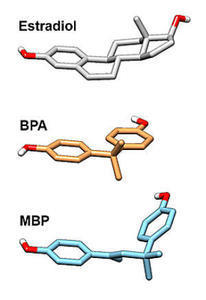Bisphenol A or BPA is the ubiquitous estrogenic compound used to create plastics. It leaches into our food stuffs and because of its hormone-like qualities elicits a myriad of health issues in adults but especially in children and most especially when exposed in utero or during key developmental phases.
As we cover the expanding research base on BPA, it becomes increasingly clear that traditional methods of toxicology do not work for understanding endocrine disruptors – the man-made chemicals that alter our hormone pathways . A case in point, the latest research on BPA.
Exposure in Adults
A report published online in June of 2011 and presented at a prominent toxicology conference in February 2013, measured BPA exposure levels over a 24-hour period in adults fed a high BPA diet (lots of canned food and water from plastic bottles). The report showed that the concentration of BPA measured from blood was below the level of detection in most of the study participants, even though urine concentrations were extremely high and indicated exposure levels above the 95th percentile of the US population.
From urine tests, researchers were able to detect an average 84% – 97% of the dosed BPA and its metabolite, BPA glucuronide – indicating a high rate of clearance from the body. The ranges varied widely by time of day (morning tests showed significantly less clearance) and gender of participant (women did not process the hormone as well as men).
The researchers argue that their failure to detect BPA in blood, combined with the high concentration in the urine meant that risk was minimal. Their reasoning, even though BPA exposure was high, most of the BPA was cleared from the body rapidly and efficiently; no harm, no foul.
Medical and science marketers latched on to this and soon every major and minor media outlet was reporting that risks were minimal. Here are just a few headlines.
No Ill Effects Found in Human BPA Exposure, says the Wall Street Journal
Majestically Scientific Federal Study on BPA has Stunning Findings: So Why is the Media Ignoring it? – says Forbes
No toxic effects from controversial food packet, says expert – the Guardian
Ahh, where to begin?
Flaws in the Research
Conflicts of interest. Always look for industry sponsorship of for research, see my previous post on evaluating endocrine research for details. The relationship between the investigators in the present study and industry are muddled, but they do exist. For more information, click here.
Below the level of detection. When researchers report that their tests are unable to detect a visible pathology or measure a particular compound that any reasonable person would expect to be present, the test is likely at fault. Below the level of detection, means just that. It does not mean the compound was not present or that it was not exerting effects, only that the tests were not sensitive enough to measure the compound. This was case here and I suspect as testing methods improve, we’ll see higher detection levels in blood.
High clearance is not the same as never exposed. In this study, not all of the hormone was recovered in the urine, only an average of 84% – 97%. That sounds like a lot. With hormones, however, small amounts do great damage. Why? Because steroid hormones are stored in fat (and other tissues). They accumulate over time and metabolize into a myriad of different hormones (metabolites), some more potent than the parent compound. After the initial exposure and certainly after repeated exposures, our bodies become little (or big) hormone factories, storing and creating more and more hormones and hormone metabolites.
Metabolites matter. Hormones are shape shifters. Every time they meet an enzyme, the interaction between the enzyme and the hormone creates a new, similar, but differently shaped hormone. Hormones are never ‘one and done’ metabolizers. Even though a large percentage of the original hormone and its primary clearance metabolite were measured from urine in the present study, one cannot assume that there were not still other metabolites circulating within the body and wreaking havoc.
BPA has metabolites. This is critical and often ignored in toxicology research. BPA is a hormone like substance and as such, it metabolizes into many different forms. BPA has metabolites that are more potent than BPA itself. New research shows that BPA metabolizes into a compound called 4-methyl-2,4-bis(4-hydroxyphenl)pent-1-ene or MBP for short. MBP is 1000-fold stronger than BPA in its estrogenic effects. MBP binds strongly to both types of estrogen receptors (ERa and ERb) and may change the activity of the cell, displacing native or endogenous estradiol. So within that 3%-16% range of BPA not cleared, comes a compound 1000 times stronger than the BPA itself. As the research progresses, who knows how many other active and potent metabolites from BPA or MBP we’ll see. With hormones, nothing is simple or straightforward.
What this Means
Avoid medical marketing, it’s usually incorrect. Learn how to evaluate endocrine disruptor research. Once you get the hang of it, you’ll be able to dismiss faulty research at a glance. More importantly, learn about hormone systems and environmental hormone disrupting chemicals. Otherwise, our children will bear the brunt of our ignorance.
A good review article: Bisphenol A and the Great Divide: A Review of Controversies in the Field of Endocrine Disruption.












While I don’t doubt that BPA and other EDCs could make you ill if you consume enough of them, the doses people are exposed to in the course of everyday living don’t seem to be enough to do very much. If we were being exposed to gender bending quantities of these chemicals, we’d know about it:
“In Puerto Rico over 10 000 cases of anomalous sexual development, including premature development of breasts and body hair and pseudo precocious puberty, were reported (Perez-Comas, 1988).
These changes were associated by the authors with high serum total oestrogens. However, the source of the oestrogen contamination was not clearly identified. Similar adverse effects were observed in Italy, believed to result from accidental contamination of food by DES (Fara et al., 1979). In addition, in 1980, analysis of Italian baby food made with homogenised veal showed the presence of DES at significant levels. This was claimed to result from implants that were not removed after slaughtering of animals.”
– Page 151, Hormones as growth promoters: the precautionary principle or a political risk assessment? (http://www.eea.europa.eu/publications/environmental_issue_report_2001_22/issue-22-part-14.pdf)
Another example is that of PBB flame retardent, one of the nastier EDCs from the “wonder drug” years:
http://www.taoslandandfilm.com/independent-films/Cattlegate-Michigan-PBB-documentary
also
http://greatlakesecho.org/2010/06/04/poisoning-michigan-an-author-revisits-the-most-widespread-contamination-30-years-later/
The article I’ve linked to above is fairly tame, but there are 103 comments from ordinary people who were caught up in the disaster. It gives a good sense of how damaging this chemical actually was to the people exposed to it!
The Michigan firemaster disaster illustrates perfectly the extent to which US government agencies are in the pockets of big business, and the lengths they’ll go to in order to protect those interests – even if it means maiming or killing large numbers of people. Repeatedly lying to both farmers and the public, confiscation of evidence, systematically falsifying lab results, certifying the meat from grossly deformed animals as fit for human consumption, even gangland-style measures such as extortion, kidnapping and death threats. It’s like something from a corny B grade sci fi movie, except this is a real event that took place in Michigan during the mid 1970s, that resulted in human fatalities as well as 9 million people being poisoned!
When toxic levels of EDCs get into our food chain, they produce noticeable effects on human health. If BPA and pthalates really were harmful in the doses people are exposed to in the course of everyday living, there’d be obvious evidence of that. There isn’t.
The chemical industry has, to a large extent, cleaned up its act. DES, PBB, DDT and all the other highly toxic, bioaccumulating chemical nasties were banned towards the end of the last century, so commonsense says environmental chemical exposure should be far less of a hazard now than it was 30 or 40 years ago. Yet suddenly we have a whole bunch of very slick, professional-looking organisations making out that there’s a huge problem with small quantities of relatively nontoxic industrial chemicals getting into our food chain. Why could that be I wonder?
Well, I think there is a massive problem with endocrine disorders and other chronic illnesses that are being caused by endocrine disrupting chemicals. However the culprit isn’t environmental toxins, it’s exposure to doctor-prescribed medicines (particularly pharmaceutical hormones) before birth.
IMO, if the truth were known, the pharmaceutical industry are probably behind most of the scaremongering about EDCs, in order to keep public attention away from their products.
The earliest widely used pharmaceutical hormone was the artificial estrogen DES. I originally started looking at DES in order to confirm a suspicion that exposure to artificial sex hormones before birth can interfere with sexually dimorphic brain development, and produce a baby whose “brain sex” doesn’t properly match their physical sex. DES certainly seems to have done that to many of the DES sons, but going on what I’ve seen, it did a whole lot of other things to both DES sons and daughters too. In fact, it seems to be linked to pretty much the entire spectrum of mysterious chronic ailments afflicting people today – fertility problems, PCOS and other endocrine disorders in women, autoimmune disorders, testicular dysgenesis, chryptorchidism, hypospadias, low testosterone, endocrine and sexual dysfunction in men, autism spectrum disorders, depression, ADHD, psychiatric illnesses, and gender dysphoria.
DES was withdrawn from use 40 years ago, but it was just the first of many similar drugs, and I think that some at least of the ones in current use must be producing (most of) the same developmental abnormalities that were seen with DES.
Artificial steroid hormones and steroid hormone mimics are probably the single most widely used and most profitable category of drug there is in the entire field of medicine. They’re a massive moneyspinner for the pharmaceutical industry and produce a great deal of medically useful effects in adults, but they also seem to have a terrible dark side to them, of producing often subtle developmental abnormalities in the unborn child, that result in all kinds of chronic debilitating illnesses later in life.
Maybe I’m wrong. Maybe you can give a pregnant woman 40 times the dose of DES required to chemically castrate an adult man with prostate cancer, and it has no effect on the physical or psychological sexual development of her unborn son. Maybe you can inject a woman with 500mg per week of hydroxyprogesterone caproate throughout the time her unborn son’s brain is undergoing it’s sexually dimorphic development, and he’ll still identify as a man later in life (when a single 160mg injection every 3 months of the related drug MPA is enough to chemically castrate a sex offender!).
If you exposed an adult man to these same treatments, there’d be major and possiby irreversible effects on his fertility, his masculinity and the functioning of his endocrine system. IMO it’s absolutely crazy to be exposing unborn babies to such high doses of these drugs, yet that’s exactly what’s happening every day in doctor’s surgeries and hospitals all over the world!